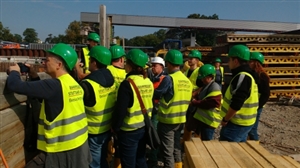A report on IET Germany's visit to the building site
On Saturday the 23rd. of September 2017 a group of IET members, friends and their families met up for a tour of the main building site for Stuttgart's Hauptbahnhof. This is part of the massive Stuttgart - Ulm Rail Project which, in turn, belongs to the Main Line for Europe (Magistrale für Europa / Magistrale européenne) between Paris and Bratislava, originally suggested by the EU in the 1990's.
In Stuttgart the main station will be rebuilt underground and transformed from a terminus to a through-station, thereby freeing a large area of inner-city land for new buildings - primarily housing.
The project was fiercely opposed by many people due to the costs involved, the technical difficulties of building in Stuttgart's unique valley location and scepticism about the capacity of the new station. After mediation efforts led by the late Heiner Geißler and subsequent improvements, a state referendum was held which rejected withholding financing for the project by a majority of 58.9% i.e. allowing the project to precede as planned.
For our tour of the building site we had an excellent turn-out of 15 visitors. We met our guide at the station's tower, which is used as a permanent exhibition centre for the project. Our guide introduced us to the exhibits and explained the key data to us. For example:
- The changes in Stuttgart include a ring of of tunnels 33 km in length.
- The planned cost for the Stuttgart part are around 6.7 billion Euros.
- In total 120 km of tunnels will be needed at a cost of around 10 billion Euros.
- The new station will have 8 tracks and will have a theoretical increase in capacity of 60%. The old terminus had 16 tracks, but all the trains had to pass through a narrow gap of only 5 tracks width, both when entering and leaving the station.
- The railway station continues to be used in full despite the large building site now located where the trains used to stop.

S21 Exhibition in the tower showing an aerial photo of the city with the new tunnels and tracks.
For the second part of our tour we were issued with safety shoes, helmets and high-visibility vests. We were driven into the main site and were able to examine one of the chalice-shaped concrete supports that will be used to support the station's roof . We were also able to see directly into the excavated site. The location of some of the new platforms and the chalice-supports are already visible. Our guide explained that the tower and facade of the station, a protected building of architectural interest, have been retained and the historic railway office nearby has had to be raised on a platform whilst tunnels are built underneath.


Our group at the main building site. The historic railway station tower can be seen in the background.
We were then able to drive the whole length of the site to the North Station which is the site of one of the tunnels. Here, the earth and debris from the tunnels is sorted, loaded into containers and transported by rail away from the site. A holding area large enough for 3 days' worth of containers is maintained in case of rail strikes or other problems. In Stuttgart most of the tunnels are being built using explosives but outside the city and on the main Ulm - Stuttgart route tunnel-boring machines are in use.
On the journey we learned lots of interesting facts about Stuttgart from our tour guide, Mr. Vogt-Moykopf, who is also an official Stuttgart city guide.
After returning in the minibus to the station we were able to return our safety gear and some of the group moved on to a local Brauhaus for refreshments.
Some "Thank You's":
- To all the visitors in our group for supporting the IET's efforts to organise events in Germany.
- To the S21 Erleben Team and our excellent guide Anselm Vogt-Moykopf
Howard Gray